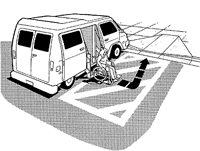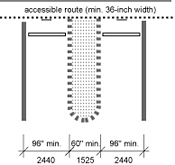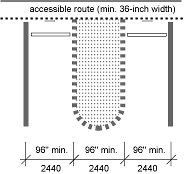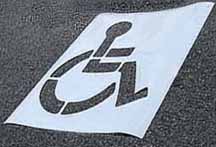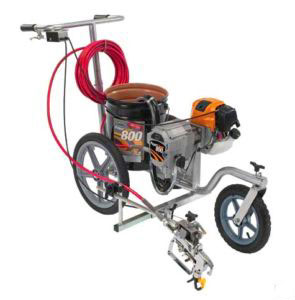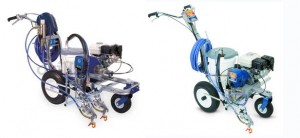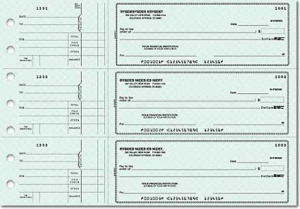Once you have gone through all the tedious steps of setting up, licensing and funding your business, you are ready to start working on a marketing program. Advertising, cold calling, an internet site, yellow page ads, logos, business cards, flyers, signs, and word of mouth are all components that make up what people refer to as “marketing”. Marketing is simply a way to bring supply and demand together. In other words, you are able to stripe a parking lot at a fair price. In your town there are hundreds of parking lots that need to be striped. Your marketing program is what will connect you to these customers. A good marketing program should have the following characteristics:
– It should professional
– It should clearly convey your message
– It should be as targeted as possible
– It should be as cost efficient as possible
– It should be as labor efficient as possible
– It should be systematic (versus disorganized and sporadic)
– It should get quick results
– It should get long lasting results
Fortunately, marketing a parking lot striping / sealcoating business is very simple and straight forward. This is true for two reasons. Number one, your potential customers are easy to identify. Number two, they are easy to reach or contact.
The first task you need to complete is to make a list of potential customers. They would consist of anyone with a parking lot and more specifically, anyone with a parking lot that needed striping. Finding these customers simply involves driving around your market area and recording addresses and names. This is the beginning of a process that will allow you to reach these potential customers with affordable targeted advertising. To reach other customers that you may have missed you would use a broader based advertising program so that customers that you did not identify initially but need striping could easily find you. I will begin with some target marketing ideas and then move on to a broad based marketing.
Target Marketing
To reach potential parking lot striping or sealcoating customers using a target marketing approach you can follow these steps.
1. Drive around your market area and list of parking lots that need striping. Record the addresses and any other information that you think is pertinent. For example, does the parking lot need striping only or sealcoating also. Are there any potholes. Maybe you want to take a picture for you records and for reference. Wherever you go you should be looking for prospects. Your wife, parents, friends, etc.. can also be very helpful in this effort.
2. Once you have compiled a list, go to the property appraisers internet site and enter the address to obtain the property owners name and address. This is sometimes out of the area which is fine. The owner is almost always the party that is ultimately responsible for keeping the parking lot in good condition. If a management company handles the property they will often forward the information you send them to that company. For shopping centers, call the number on the “for lease” signs in the windows of available units. Obtain the address and send a letter to the company that manages the project. There is no problem sending a letter to the owner and management company. For hospitals, malls, factories, and other similar businesses use the main address for the facility and write on the envelope “Attention Maintenance Supervisor”.
3. Send marketing packages to the individuals and companies that you have identified. The package should outline what your company does and present an offer to stripe or sealcoat their parking lot. Include your business card and any other information such as number of years in business, jobs you have done, hours of operation, insurance and workers compensation information. Make a list on your computer of who you have sent letters to. As you receive responses make a note of them for tracking purposes. After a few months resend letters to companies who have not responded. If you send out marketing information every few months to a person it should not be an imposition. If you send letters weekly it would be. If you notice that the lot has been striped just mark them off the list. A spreadsheet of composition book can be used to track you marketing efforts. This will be an ongoing process that will never stop. You may slow it down or speed it up if necessary.
This type of targeted marketing will usually get you all the jobs you need in a fairly short amount of time. All for the cost of a few rolls of stamps and some gas money.
Broad Based Marketing
Many times there are lots that need striping that you will not find on your own. They may be off the beaten path or out of your area. If a person needs their lot striped or sealcoated and you do not find them then they are going to need to find you. Broad based marketing does this by making your business information available to anyone who looks for it. They should not have to look very hard to find you. In fact if you are the easiest to find you will always get the first call. The idea is to accomplish this without spending a fortune. The yellow pages would be an example of broad based advertising. You can find below several broad based marketing ideas starting from the least expensive way to the most expensive way.
1. Google Local Business. If you search on www.google.com for “google local business” and you should find links that will allow you to place your business on googles special local business section for free. When someone in your area types in parking lot striping your business along with pertinent information about your company will come up.
2. Yahoo Local Business. Do a search on www.yahoo.com for yahoo local business and you will get links into their free business listing area. This is very much like the google service and it is also free. Look for the “add business” link at the bottom of the page.
3. Craigslist.org is a free advertising service that is very popular and available all over the country. It is localized in that there are special craigslist pages for most major cities in the US. Advertise on the one nearest you.
4. Business Website. Having your own website is and not expensive and is a great way convey large amounts of information to potential customers. There are many good companies that have online web building tools for you to use. Use a lot of content because google matches customers to you based on content. Make sure your title includes the city you are in. You would use something like Affordable Parking Lot Striping Los Angeles CA . This will let the search engines know where you are. Look at other striping company websites and see how they are laid out and you should get a good idea of how you want yours to look.
5. Local newspaper business & service directories. Most papers have a local business/service directory that are fairly inexpensive to advertise in. Put your business in as many of these publications as you can afford. It is often worth the money to pay a little extra to make your ad more visible than the rest.
6. Yellow Page advertising. This used to be the best way to reach people. It has also always been very expensive. Now, with the internet it has become less important. If you have a business phone you will most likely get a free listing. If you pay a little more you can get a larger inline listing. I personally would recommend an in column type ad or just pay extra to make the standard free ad bold.
7. Signs on Telephone Poles or the Roadside. Most counties do not allow very much of this but check with yours to see. Even if they are banned in your area you can always find a legal place to put them. A sign company can make affordable small signs for you that say Parking Lots Striped and then your phone number. This type of advertising it is fairly effective and will normally get you a few jobs each year.
Finally, bidding jobs is a very important part of marketing. It is the part of your marketing program that everything else leads up to. Sort of like stepping up to home plate. Dress nice but not too nice. Come in your work truck and not your wife’s Lexus. Make sure you show up on time. Make sure your bid sheet is neat and professional. Itemize different parts of the job without giving too much detail or making it confusing. Make sure the customer has all the information they need to make a decision. Include your business license , insurance and workers comp info on the letter at the bottom so they know these items are covered.
If you follow these basic steps you should be able to stay as busy as you want to be.
To see more of our parking lot striping articles CLICK HERE.
